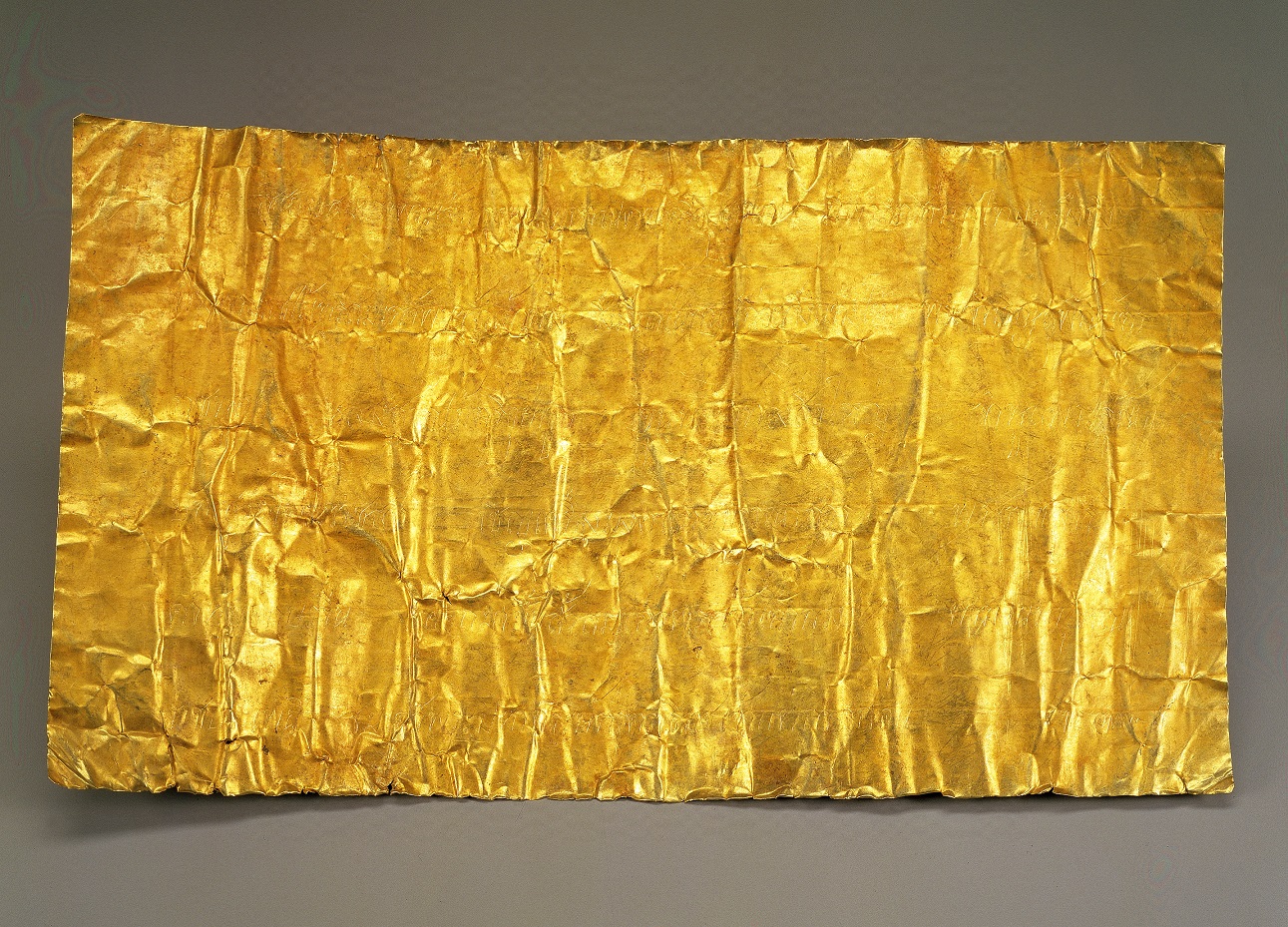
Gold-leaf Tributary Document from Siam
This is the "Gold-leaf Tributary Document from Siam" with highly exquisite binding. Although the word "piao" was the term that Qing dynasty government required that its vassal states use to refer to themselves when writing to the emperors of China, whether the vassal states accepted and approved such position held by China as a heavenly monarchy remain to be deciphered from the content of the piao. On May 26, 1781, Taksin (1734-1782), the king of Siam, sent his envoy on a tribute mission to the Qing government; the list of tribute items, which is currently housed in the National Palace Museum, contains one gold-leaf tributary document, a male elephant, a female elephant, ligumaloes, ambergris, diamonds, Western blankets, peacock feathers, green leather, ivories, rhino horns, Acronychia pedunculata, sandalwood, resin of sweetgum, camphor, bifa, cardamoms, gamboges, chaulmoogratree seeds, ebonies, cinnamons, honey skin, Sappanwood, among others. In addition to these "official" tributes, Taksin also prepared a male elephant, one picul of rhino horns, 100 piculs of ivories, 300 piculs of yangxi, 100 piculs of gamboges, 3,000 piculs of pepper, and 1,000 piculs of Sappanwood; these tributes were excluded from the official list of tributes for fear of the tributes exceeding the tribute limit. Experts generally believe that this "Gold-leaf Tributary Document from Siam" was sent by Taksin. Taksin, who successfully repelled the invading Burmese army, was promoted to the King of Siam. Assuming the post for the first time, Taksin prepared a rather generous collection of tributes to gain the recognition of his sovereign state and to consolidate his political status. According to the Huojidang of the Imperial Household Department, gold-leaf tributary documents submitted by vassal states were commonly melted by the Qing court to be used for other purposes, making the number of documents remaining extremely low and this existing piece remarkably precious.
ทองเอกสารแควจากสยาม
"นี่คือ "ทองแควเอกสารจากสยาม" กับประณีตสูงที่มีผลผูกพัน แม้ว่าคำว่า "เปรี้ยว" เป็นคำที่ว่ารัฐบาลราชวงศ์ชิงที่จำเป็นที่รัฐข้าราชบริพารของใช้ในการอ้างถึงตัวเองเมื่อเขียนถึงจักรพรรดิของจีนไม่ว่าจะเป็นสหรัฐอเมริกาข้าราชบริพารได้รับการยอมรับและได้รับการอนุมัติตำแหน่งดังกล่าวจัดขึ้นโดยจีนเป็นพระมหากษัตริย์ผู้ทรงสถิตในสวรรค์ยังคงเป็น ถอดรหัสจากเนื้อหาของเปรี้ยวที่ วันที่ 26 พฤษภาคม 1781 ตากสิน (1734-1782) กษัตริย์แห่งสยามส่งทูตของเขาในภารกิจส่วยให้รัฐบาลชิง; รายชื่อของรายการส่วยซึ่งเป็นปัจจุบันอยู่ในพิพิธภัณฑ์พระราชวังแห่งชาติมีเอกสารหนึ่งทองแควช้างชาย, ช้างหญิง ligumaloes ไขปลาวาฬเพชร, ผ้าห่มตะวันตกขนนกยูงหนังสีเขียว, เปียโน, แรด แตรพูมารีจันทน์เรซิน Sweetgum การบูร bifa, cardamoms, gamboges เมล็ด chaulmoogratree, ebonies, Cinnamons ผิวน้ำผึ้งซางหมู่คนอื่น ๆ นอกจากนี้บรรณาการ "อย่างเป็นทางการ" ตากสินยังเตรียมช้างชายหนึ่ง picul แตรแรด 100 piculs ของเปียโน 300 piculs ของ Yangxi 100 piculs ของ gamboges 3,000 piculs ของพริกไทยและ 1,000 piculs ของซาง; บรรณาการเหล่านี้ได้รับการยกเว้นจากรายการอย่างเป็นทางการของบรรณาการความกลัวของบรรณาการเกินขีด จำกัด ส่วย ผู้เชี่ยวชาญโดยทั่วไปเชื่อว่า "ทองแควเอกสารจากสยาม" ถูกส่งมาจากตากสิน ตากสินที่ประสบความสำเร็จมันไส้กองทัพพม่าบุกเข้ามาได้รับการเลื่อนตำแหน่งให้เป็นกษัตริย์แห่งสยาม สมมติว่าการโพสต์เป็นครั้งแรก, ตากสินจัดทำคอลเลกชันค่อนข้างใจกว้างของบรรณาการได้รับการยอมรับของรัฐอธิปไตยของเขาและจะรวมสถานะทางการเมืองของเขา ตามที่ Huojidang ของจักรพรรดิกรมครัวเรือนเอกสารแควทองส่งโดยรัฐศักดินาถูกละลายโดยทั่วไปศาลชิงเพื่อนำไปใช้เพื่อวัตถุประสงค์อื่น ๆ ทำให้จำนวนของเอกสารที่เหลืออยู่ในระดับต่ำมากและชิ้นส่วนที่มีอยู่นี้มีค่าอย่างน่าทึ่ง"
ปล.กูเกิ้ลเอื้อเฟื้อการแปลนะครับ --*

สารจากสยาม ถวายจักรพรรดิเฉียนหลง
This is the "Gold-leaf Tributary Document from Siam" with highly exquisite binding. Although the word "piao" was the term that Qing dynasty government required that its vassal states use to refer to themselves when writing to the emperors of China, whether the vassal states accepted and approved such position held by China as a heavenly monarchy remain to be deciphered from the content of the piao. On May 26, 1781, Taksin (1734-1782), the king of Siam, sent his envoy on a tribute mission to the Qing government; the list of tribute items, which is currently housed in the National Palace Museum, contains one gold-leaf tributary document, a male elephant, a female elephant, ligumaloes, ambergris, diamonds, Western blankets, peacock feathers, green leather, ivories, rhino horns, Acronychia pedunculata, sandalwood, resin of sweetgum, camphor, bifa, cardamoms, gamboges, chaulmoogratree seeds, ebonies, cinnamons, honey skin, Sappanwood, among others. In addition to these "official" tributes, Taksin also prepared a male elephant, one picul of rhino horns, 100 piculs of ivories, 300 piculs of yangxi, 100 piculs of gamboges, 3,000 piculs of pepper, and 1,000 piculs of Sappanwood; these tributes were excluded from the official list of tributes for fear of the tributes exceeding the tribute limit. Experts generally believe that this "Gold-leaf Tributary Document from Siam" was sent by Taksin. Taksin, who successfully repelled the invading Burmese army, was promoted to the King of Siam. Assuming the post for the first time, Taksin prepared a rather generous collection of tributes to gain the recognition of his sovereign state and to consolidate his political status. According to the Huojidang of the Imperial Household Department, gold-leaf tributary documents submitted by vassal states were commonly melted by the Qing court to be used for other purposes, making the number of documents remaining extremely low and this existing piece remarkably precious.
ทองเอกสารแควจากสยาม
"นี่คือ "ทองแควเอกสารจากสยาม" กับประณีตสูงที่มีผลผูกพัน แม้ว่าคำว่า "เปรี้ยว" เป็นคำที่ว่ารัฐบาลราชวงศ์ชิงที่จำเป็นที่รัฐข้าราชบริพารของใช้ในการอ้างถึงตัวเองเมื่อเขียนถึงจักรพรรดิของจีนไม่ว่าจะเป็นสหรัฐอเมริกาข้าราชบริพารได้รับการยอมรับและได้รับการอนุมัติตำแหน่งดังกล่าวจัดขึ้นโดยจีนเป็นพระมหากษัตริย์ผู้ทรงสถิตในสวรรค์ยังคงเป็น ถอดรหัสจากเนื้อหาของเปรี้ยวที่ วันที่ 26 พฤษภาคม 1781 ตากสิน (1734-1782) กษัตริย์แห่งสยามส่งทูตของเขาในภารกิจส่วยให้รัฐบาลชิง; รายชื่อของรายการส่วยซึ่งเป็นปัจจุบันอยู่ในพิพิธภัณฑ์พระราชวังแห่งชาติมีเอกสารหนึ่งทองแควช้างชาย, ช้างหญิง ligumaloes ไขปลาวาฬเพชร, ผ้าห่มตะวันตกขนนกยูงหนังสีเขียว, เปียโน, แรด แตรพูมารีจันทน์เรซิน Sweetgum การบูร bifa, cardamoms, gamboges เมล็ด chaulmoogratree, ebonies, Cinnamons ผิวน้ำผึ้งซางหมู่คนอื่น ๆ นอกจากนี้บรรณาการ "อย่างเป็นทางการ" ตากสินยังเตรียมช้างชายหนึ่ง picul แตรแรด 100 piculs ของเปียโน 300 piculs ของ Yangxi 100 piculs ของ gamboges 3,000 piculs ของพริกไทยและ 1,000 piculs ของซาง; บรรณาการเหล่านี้ได้รับการยกเว้นจากรายการอย่างเป็นทางการของบรรณาการความกลัวของบรรณาการเกินขีด จำกัด ส่วย ผู้เชี่ยวชาญโดยทั่วไปเชื่อว่า "ทองแควเอกสารจากสยาม" ถูกส่งมาจากตากสิน ตากสินที่ประสบความสำเร็จมันไส้กองทัพพม่าบุกเข้ามาได้รับการเลื่อนตำแหน่งให้เป็นกษัตริย์แห่งสยาม สมมติว่าการโพสต์เป็นครั้งแรก, ตากสินจัดทำคอลเลกชันค่อนข้างใจกว้างของบรรณาการได้รับการยอมรับของรัฐอธิปไตยของเขาและจะรวมสถานะทางการเมืองของเขา ตามที่ Huojidang ของจักรพรรดิกรมครัวเรือนเอกสารแควทองส่งโดยรัฐศักดินาถูกละลายโดยทั่วไปศาลชิงเพื่อนำไปใช้เพื่อวัตถุประสงค์อื่น ๆ ทำให้จำนวนของเอกสารที่เหลืออยู่ในระดับต่ำมากและชิ้นส่วนที่มีอยู่นี้มีค่าอย่างน่าทึ่ง"
ปล.กูเกิ้ลเอื้อเฟื้อการแปลนะครับ --*